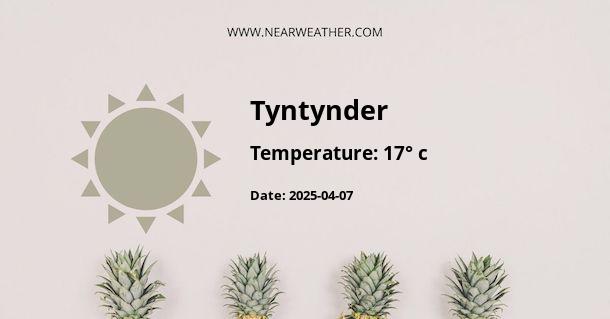Tyntynder, Australia: Climate and Weather Year Round
Tyntynder is a small town located in the state of Victoria, Australia. It is known for its picturesque landscapes, rich agricultural heritage, and diverse climate. In this article, we will explore the climate and weather conditions in Tyntynder throughout the year, providing you with a comprehensive understanding of what to expect when visiting or residing in this beautiful region.
Geographical Location
Tyntynder is situated in the heart of the Murray Mallee region of Victoria. It is located approximately 317 kilometers northwest of Melbourne, the state capital. The town is surrounded by vast farmlands and stretches of natural bushland, making it a unique destination for nature lovers.
Climate Classification
Tyntynder falls under a semi-arid climate classification, specifically a Mediterranean climate (Csa) according to the Köppen climate classification system. This type of climate is characterized by hot, dry summers and mild, wet winters. However, due to its inland location, Tyntynder experiences some variations in temperature and rainfall patterns compared to coastal areas.
Temperature
Throughout the year, Tyntynder experiences a wide range of temperatures. Summers (December to February) are hot, with average maximum temperatures ranging from 30 to 35 degrees Celsius (86 to 95 degrees Fahrenheit). Heatwaves are not uncommon during this period, with temperatures occasionally reaching above 40 degrees Celsius (104 degrees Fahrenheit).
Winters (June to August) in Tyntynder are generally mild, with average maximum temperatures ranging from 13 to 16 degrees Celsius (55 to 61 degrees Fahrenheit). Frost can occur during the early morning hours, particularly in July and August, resulting in chilly mornings and evenings.
Rainfall
Tyntynder receives most of its rainfall during the winter months, with July being the wettest month. The region has an annual average rainfall of approximately 400-500 millimeters (15.7-19.7 inches). However, it is important to note that rainfall can vary significantly from year to year due to natural climate variability.
The summer months in Tyntynder are generally dry, with limited rainfall. This dry period, combined with the hot temperatures, increases the risk of bushfires in the surrounding areas.
Extreme Weather Events
Like many parts of Australia, Tyntynder is susceptible to extreme weather events, including heatwaves, bushfires, and occasional flooding. Heatwaves can be particularly dangerous, with prolonged periods of high temperatures posing risks to human health and agriculture.
Bushfires are a significant concern during the summer months, especially when combined with dry conditions and strong winds. It is important to stay informed about fire danger ratings and follow advice from local authorities to ensure personal safety.
Occasional flooding can occur in Tyntynder and surrounding areas, typically during periods of heavy rainfall. Local authorities closely monitor river levels and issue warnings when necessary to mitigate the risks associated with flooding.
Recommended Activities for Each Season
With its diverse climate and beautiful landscapes, Tyntynder offers a range of activities for visitors and residents throughout the year. Here are some recommended activities for each season:
Summer (December to February)
- Explore the nearby Murray River for water activities such as swimming, boating, and fishing.
- Visit local wineries and enjoy wine tasting tours in the region.
- Take scenic drives through the countryside and enjoy the picturesque landscapes.
Autumn (March to May)
- Witness the stunning autumn colors as the leaves change in the surrounding forests.
- Participate in local harvest festivals and farmers' markets showcasing the region's agricultural produce.
- Go on hiking or cycling trails and explore the natural beauty of the area.
Winter (June to August)
- Experience the tranquility of the winter landscape and enjoy peaceful walks in the countryside.
- Visit local art galleries and museums to appreciate the region's cultural heritage.
- Attend community events and festivals held during the winter months.
Spring (September to November)
- Witness the blooming of wildflowers and enjoy nature walks in the nearby nature reserves.
- Participate in birdwatching activities, as many migratory birds visit the region during this season.
- Take part in outdoor sports and recreational activities, such as golf, tennis, or cricket.
Regardless of the season, it is advisable to check the local weather forecast and plan accordingly, especially when engaging in outdoor activities.
Conclusion
Tyntynder, Australia, offers a unique climate and weather experience throughout the year. From hot, dry summers to mild, wet winters, the region showcases the best of a semi-arid Mediterranean climate. Visitors and residents can enjoy a variety of activities, ranging from water sports in summer to nature walks in autumn and peaceful winter landscapes. However, it is important to stay informed about extreme weather events, such as heatwaves, bushfires, and occasional flooding, to ensure personal safety. Overall, Tyntynder provides a beautiful setting to explore the natural wonders and cultural heritage of the Murray Mallee region.
A - Tyntynder's Latitude is -35.233330 & Longitude is 143.466675.
A - Weather in Tyntynder is 17° today.
A - Climate Conditions in Tyntynder shows clear sky today.
A - Humidity in Tyntynder is 51% today.
A - Wind speed in Tyntynder is 17.32 km/h, flowing at 214° wind direction. today.
